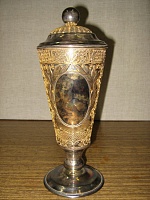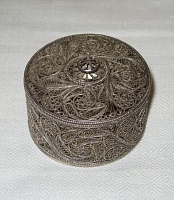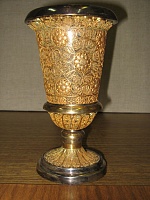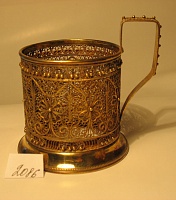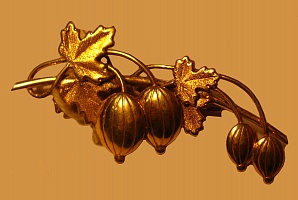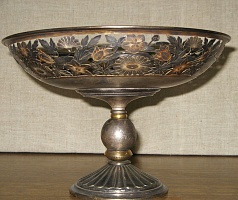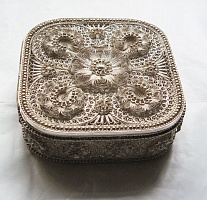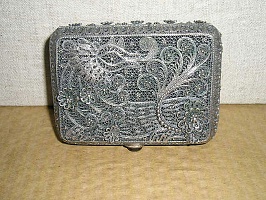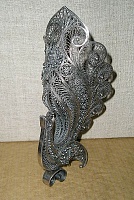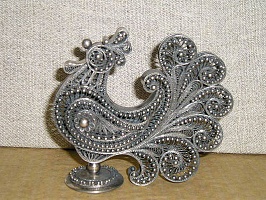The 20th Century Works Of Jewelry Art From Krasnoye Selo
They are mainly products of the following co-operatives and collective farms: “Krasny Kustar” [Red Artisan] ( Krasnoye village), “Po zavetam Ilyicha” [To the Behests of Ilyich] (Podolskoye village), “Iskra Oktyabrya” [October Sparkle] (Aleyevo village), also works of the Krasnoye Selo Jewelry Factory and the Krasnoye Selo Jewelry Plant. The collection comprises tableware, jewelry decorations, cassettes and boxes, goblets, decorative sculptures.
Krasnoye Selo is one of the most famous handicraft centers producing artistic works of silver. It appeared in the middle ages and expanded around Krasnoye village in the 19th century. The handicraftsmen from other 27 villages were also engaged in jewelry art. In 1912, the pupils of the workshop organized a handicraft artel. After 1917, the Krasnoye Selo jewelers united in handicraft cooperatives. In 1930, in Krasnoye village was organized the Krasnoye Selo jewelry handicraft union, including 4 large artels – in Krasnoye village, in Sidorovskoye, Podolskoye, Derbilki and 14 affiliate collective farm artels in the district.
The Krasnoye Selo jewelers had no local traditions, so they turned to the artistic heritage of Novgorod, Moscow, Solvychegodsk and, at the same time, they tried to find their own style, developing new filigree elements – “rings”, “tape”, “brackets”, “cucumbers”, etc. The articles were mainly of silver, occasionally of copper with frequent electroplating – gilding and silvering. In the 1930s, the handicraft artel “Krasny Kustar” [Red Handicraftsman] was the largest in the Kostroma region, it produced various articles: cassettes, boxes, cigarette cases, filigree brooches, clasps, buttons. In the post-war period the product line developed, the artel began to produce goblets, vases-goblets and memorial plates. That period is represented by few items, including interesting works of M.A. Rassadin and A.G. Golikov (artel “Krasny Kustar”).
I.A. Malyshev (artel “Iskra Oktyabrya” [October Sparkle]) was a jeweler of superb technique. He, like other masters in the artel, made tableware articles (wine vessels, tea strainers, forks, spoons). Small stamped articles with mat surfaces were decorated with engraved gilded patterns and subsequent electroplating inside. His works, preserved in the Museum, were made between 1947 and 1954.
The works of the 1950s are richly represented in the Museum collection. They comprise works of the leading artists of the Krasnoye Selo handicraft artels, including items, made by a rare professional filigree craftswoman A.V. Vasina (artel “Krasny Kustar” [Red Handicraftsman]). Her works vary from miniature articles – buttons, brooches, clasps, bracelets - to more massive vases, cracker plates, goblets, cup holders, cassettes. They were made of copper, silver and artificial stones.
The Krasnoye Selo samples of the 1950s included remarkable female decorations of silver and copper. They were most traditional products of Podolskoye and Sidorovskoye artels. A Podolskoye artist L.A. Metlin (artel “Po zavetam Ilyicha” [To the Behests of Ilyich]) was a skilful jeweler. The style of jewelry works of the 1950s was considerably influenced by the fashion. The most popular articles were traditional Krasnoye Selo brooches in the shape of branches with inserted pieces of colored glass looking like kinds of fruit, berries or flowers. Such articles are represented by the works of Z.A. Volkova, V.A. Gusyatnikova, A.P. Rybkina.
The Museum preserves six authors’ replicas of graduation works of the Krasnoye Selo Secondary Technical School - the only Russian artistic metal school. The replicas, created in 1954, include highly professional works of T.G. Khramtsova, N.A. Kashina, O.S. Barysheva.
The new step in the development of Krasnoye Selo jewelry art began in the 1960s. In 1961, artels “Krasny Kustar”, “Metallist” and the workshop of the district handicraft complex formed the single enterprise, named Krasnoye Selo Jewelry Factory, and in 1973, the Factory was converted to the Krasnoye Selo Jewelry Plant.
At that time they mainly produced articles of colored metals with subsequent galvanic treatment. Silver was replaced by copper, tombac, cupronickel, aluminium. Decorative articles and souvenirs were usually embellished with filigree. There spread small panels, trays, conventional animal sculptures. The Museum preserves samples made by P.I. Chulkov.
The experimental section of the Krasnoye Selo Jewelry Plant formed a group of talented jewelers, including P.I. Chulkov, I.D. Orlov, N.A. Sokolova and others. In distinction from the specialty of the 1960s and 1970s, they produced more gold and silver items with fianit, chrome-diopside, nephrite and agate. Works of filigree combined with enamel were also made
The works of 1980s – 1990s are represented by original exhibition samples, created by S.A. Bezrukov, V.F. Marina, T.P. Medvedeva, E.A. Larichev, Z.G. Korzina. Created in terms of tradition, the items also reflected general stylistic and formative processes of that period. All works are of elaborate relief shape with multilayer open-work filigree.
In the 1990s, filigree was still the main technique in Krasnoye Selo works. Inspired by beauty of the Volga area, the jewelers achieved original artistic presentations, worked out new images and forms for their creative works
The Museum collection of the Krasnoye Selo handicraft illustrates main steps in its development in the Soviet period: the formation in the 1930s, intensive expanding in the 1950s and flowering in the 1980s – 1990s. Though the collection is not large, it includes superb specimens, produced by the leading artists of this center. The main part of the collection comprises original creative works of art.
O.N. Yurova









